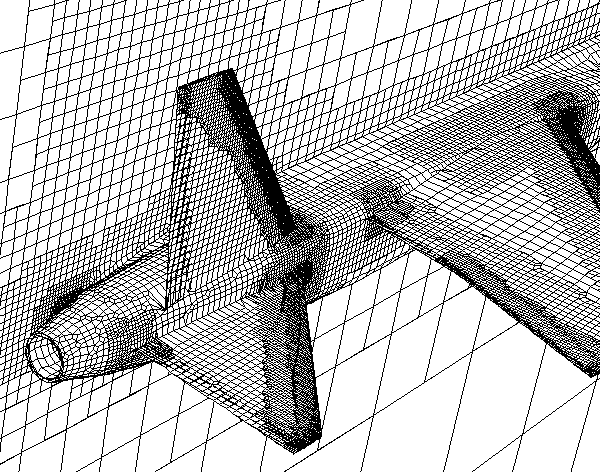
A Perspective on Cartesian Meshing
The ease of Cartesian or wrapper-based meshing for Computational Fluid Dynamics (CFD), including immersed boundary methods, is predicated on having a suitable surface mesh (e.g., STL) as an input. That surface mesh has certain constraints that, if not satisfied, will either cause a poor final mesh or can cause the Cartesian meshing process to fail.
 CFD Cartesian MeshSource: Richard Smith EngD Thesis 1996
CFD Cartesian MeshSource: Richard Smith EngD Thesis 1996
Constraints
A Cartesian mesh generator requires a surface mesh as the basis for the generation process. The surface mesh has to satisfy certain constraints:
- If gaps between surfaces are permitted then those gaps have to be significantly smaller than the local Cartesian mesh elements to prevent the Cartesian elements leaking inside the geometry.
- To accurately capture curvature the surface facets have to be significantly smaller than the local Cartesian mesh elements, otherwise no matter how much you refine the Cartesian mesh you will end up with better resolution of the wrong geometry (i.e., facets) and not the original smooth representation.
- Once a faceted representation is passed to a Cartesian mesh generator there is usually no recourse back to the original geometry during the cell generation process which introduces inaccuracies if the original geometry was analytic (e.g., NURBS), and this inaccuracy is amplified in high curvature regions.
- Often the transfer format (e.g., STL) for a Cartesian mesh generator does not carry with it the topology of the original geometry, meaning you have to use error prone angle-based facet splitting to recover the feature edges of the boundaries.
Surface Mesh Generation
The facets produced in a CAD system (a typical source for geometry) are usually optimized for visualization and therefore they typically do not satisfy these special Cartesian mesh generator needs. Clearly there is a specific type of surface mesh required for a Cartesian mesh generator and often it requires an iterative process to get an acceptable surface resolution via the facet controls within a CAD system.
Conclusion
Cartesian meshing does have some advantages over other meshing algorithms, but it is not a silver bullet. Starting the Cartesian mesh generation process with an acceptable surface mesh does not mean the overall process of meshing, which includes surface meshing, is necessarily any easier than a tetrahedral meshing process. With a good surface mesh tetrahedral meshing is typically easy too.
- symscape's blog
- Login to post comments
Select Language
Recent blog posts
- CFD Simulates Distant Past
- Background on the Caedium v6.0 Release
- Long-Necked Dinosaurs Succumb To CFD
- CFD Provides Insight Into Mystery Fossils
- Wind Turbine Design According to Insects
- Runners Discover Drafting
- Wind Tunnel and CFD Reveal Best Cycling Tuck
- Active Aerodynamics on the Lamborghini Huracán Performante
- Fluidic Logic
- Stonehenge Vortex Revealed as April Fools' Day Distortion Field

